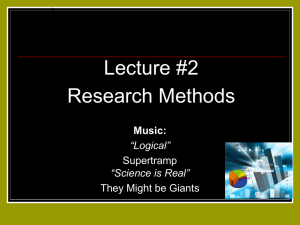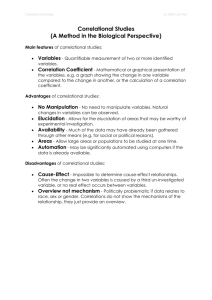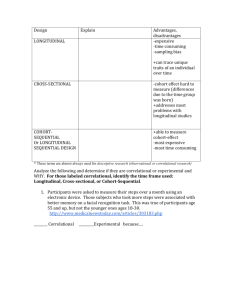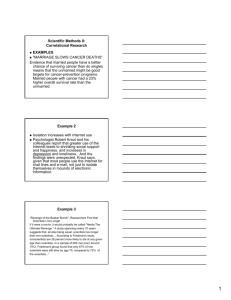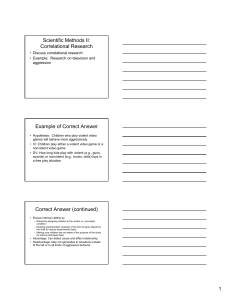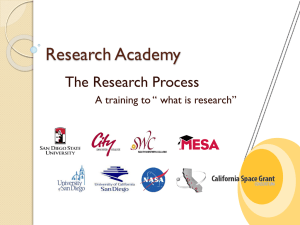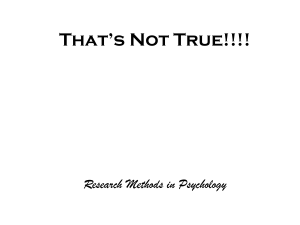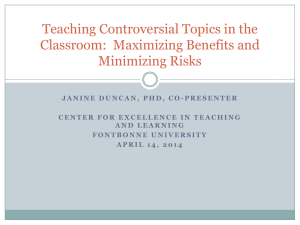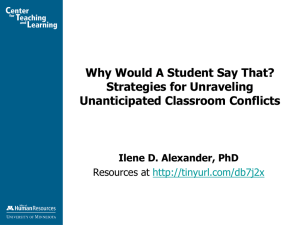Research Methods
advertisement
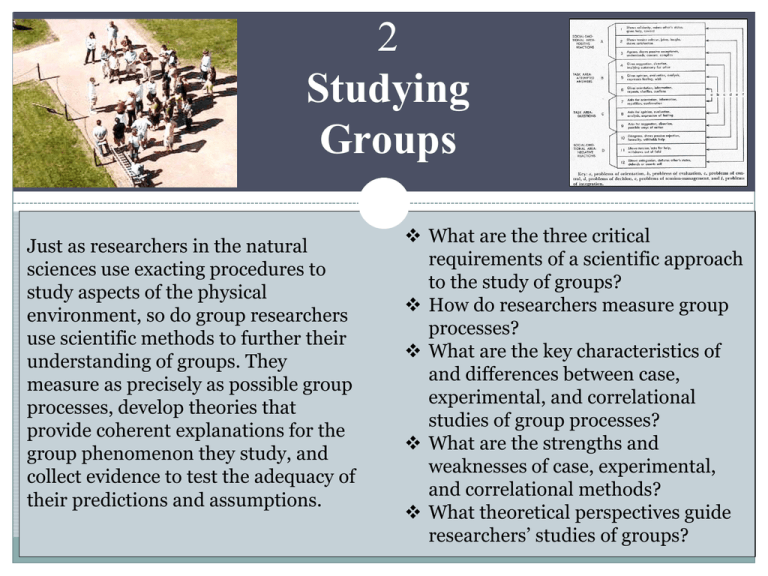
2 Chapter 3 Studying Inclusion and Identity Groups Just as researchers in the natural sciences use exacting procedures to study aspects of the physical environment, so do group researchers use scientific methods to further their understanding of groups. They measure as precisely as possible group processes, develop theories that provide coherent explanations for the group phenomenon they study, and collect evidence to test the adequacy of their predictions and assumptions. What are the three critical requirements of a scientific approach to the study of groups? How do researchers measure group processes? What are the key characteristics of and differences between case, experimental, and correlational studies of group processes? What are the strengths and weaknesses of case, experimental, and correlational methods? What theoretical perspectives guide researchers’ studies of groups? 2 Studying Groups Measurement Research Methods Theoretical Perspectives Observation Case Studies Motivation & Emotion Self-report Experiments Behavioral Correlational Studies Systems Issues Cognitive Biological What Are the Three Critical Requirements of a Scientific Study of Groups? Reliable and valid measurement Research procedures to test hypotheses about groups Theories that organize knowledge of groups Measurement Observation William Foote White’s study of “corner boys” in Street Corner Society Types: Overt Covert Participant The Nortons Doc Bill Danny Mike Long John Nutsy Angelo Frank Fred Carl Joe Lou Tommy Alec Issue: Hawthorne Effects Measurement Observation Types: Qualitative vs. Quantitative (structured) Example: Robert Freed Bales Interaction Process Analysis system Measurement Self-report Self-report measures: group members describe their perceptions and experiences Example: Moreno's sociometry method A Sociogram Out In Social network analysis Long John Tommy Carl Angelo Nutsy Frank Doc Joe Alex Mike Fred Danny Lou Research Methods Case Studies Experiments Correlational Studies Issues Research Methods Case Studies An in-depth analysis of one or more groups based on interviews, observation, analysis of archival documents, and so on. Example: Irving Janis’s analysis of groupthink Research Methods Case Studies Other examples Research Methods Experiments Key Ingredients: • Manipulate one or more independent variables Example: Lewin, Lippitt, & White’s leadership study • Measure one or more dependent variables • Control other variables, as much as possible Strength: Causal inference Research Methods Correlational Studies Example: Newcomb’s Bennington Study Key Ingredients: • Measure two or more variables • Assess the strength of the relationship between the variables Called “correlational” studies because the findings are often expressed in the form of a correlational coefficient Issues Key Characteristics of, and Differences Between Case, Experimental, and Correlational Studies of Group Processes Case studies: atypical of most groups, subjective, stimulate theory Experiments: too artificial, not “real” groups, but clearest test of cause and effect Correlational studies: limited information about causality but precise estimates of the strength of relationships, less artificial, fewer ethical concerns Studying Groups Measurement Research Methods Theoretical Perspectives Observation Case Studies Motivation & Emotion Self-report Experiments Behavioral Correlational Studies Systems Issues Cognitive Biological Theoretical Perspectives Behavioral Example: Social exchange theory Satisfaction Level Quality of Alternatives Investment Size Commitment Level Stay? Theoretical Perspectives Systems Example: InputProcess-Output Model of Group Performance Theoretical Perspectives Cognitive The relationship between perceptional/ inferential processes and group-level processes Example: Group Referent Effect Theoretical Perspectives Biological Brain regions recruited during social rejection Biological perspectives, such as evolutionary theory, argue that some group behaviors may be rooted in physiological and neurological processes. Anterior insula Chapter 2: Studying Groups 20 Measurement Research Methods Theoretical Perspectives Observation Case Studies Motivation & Emotion Self-report Experiments Behavioral Correlational Studies Systems Issues Cognitive Biological
